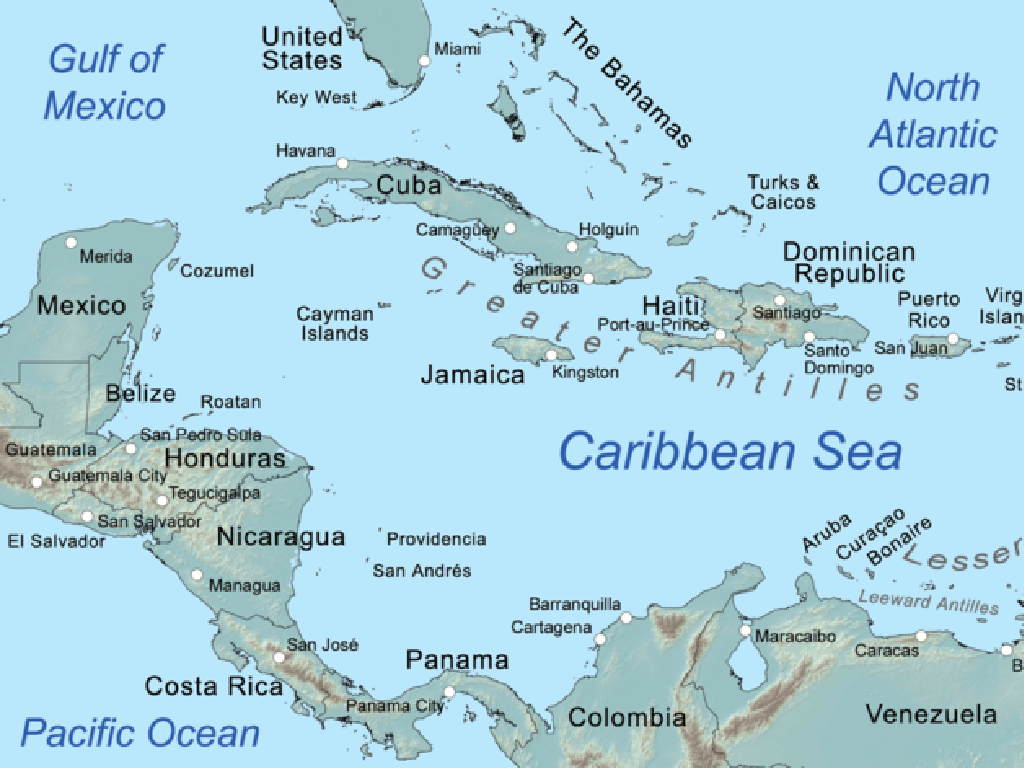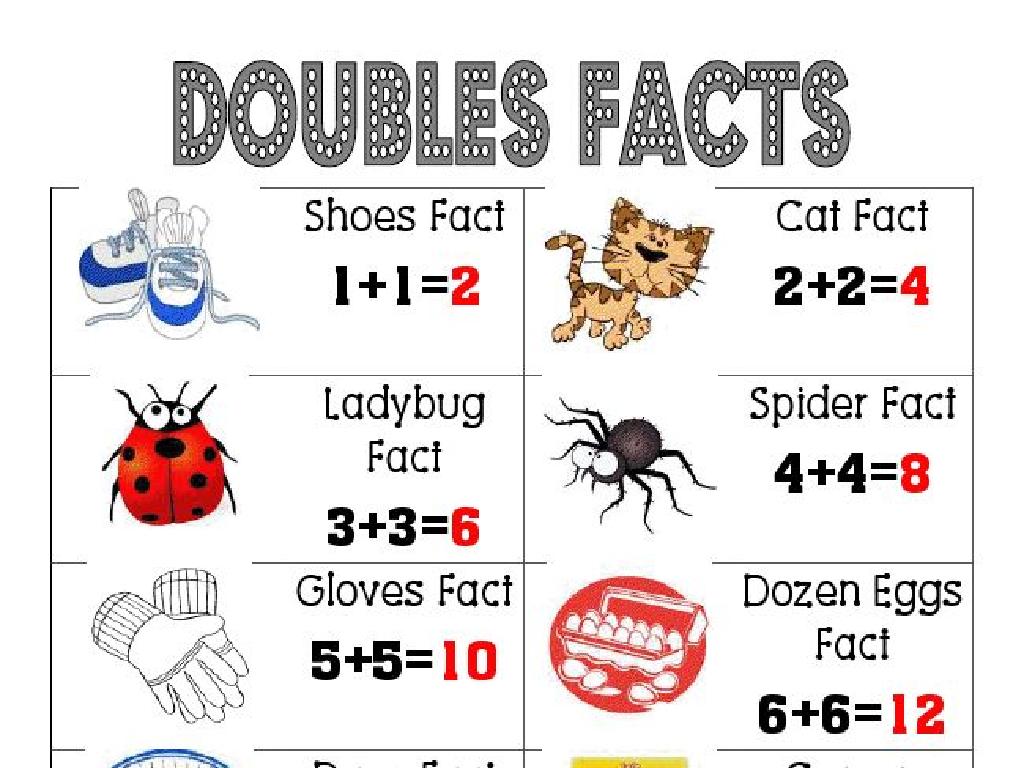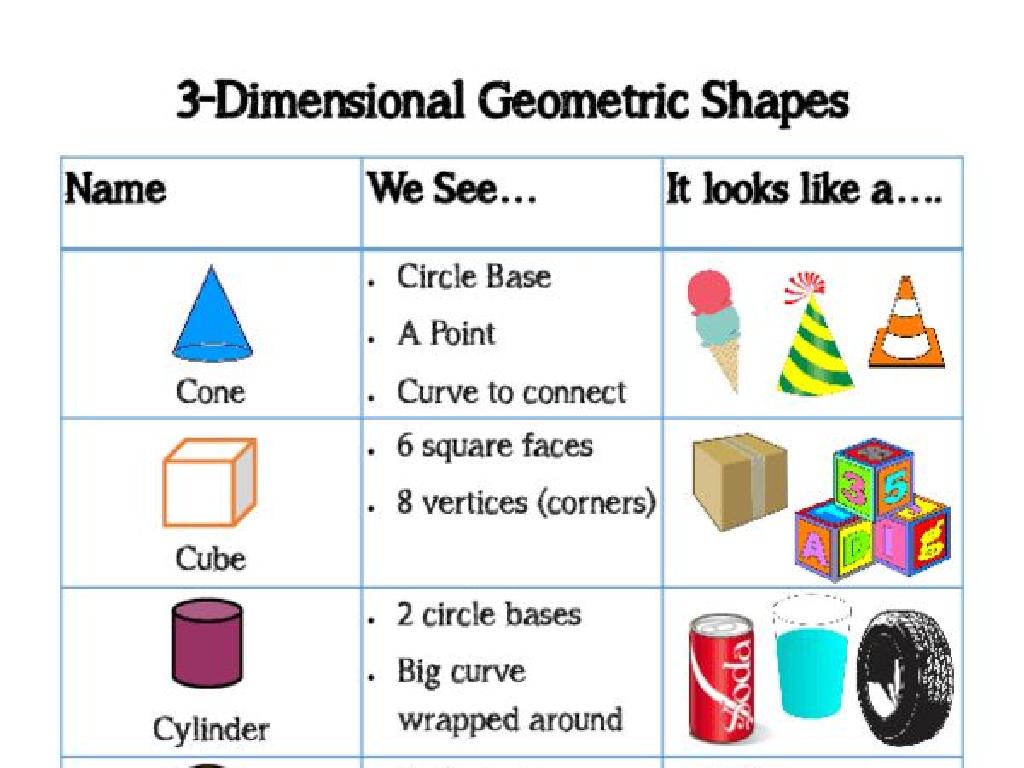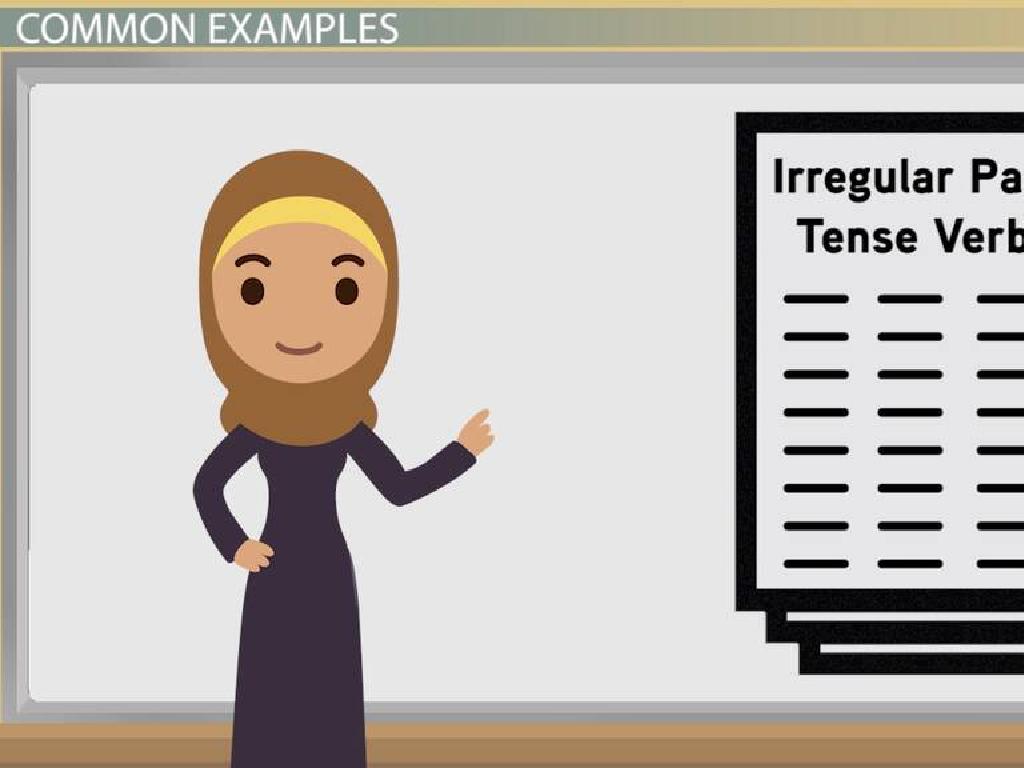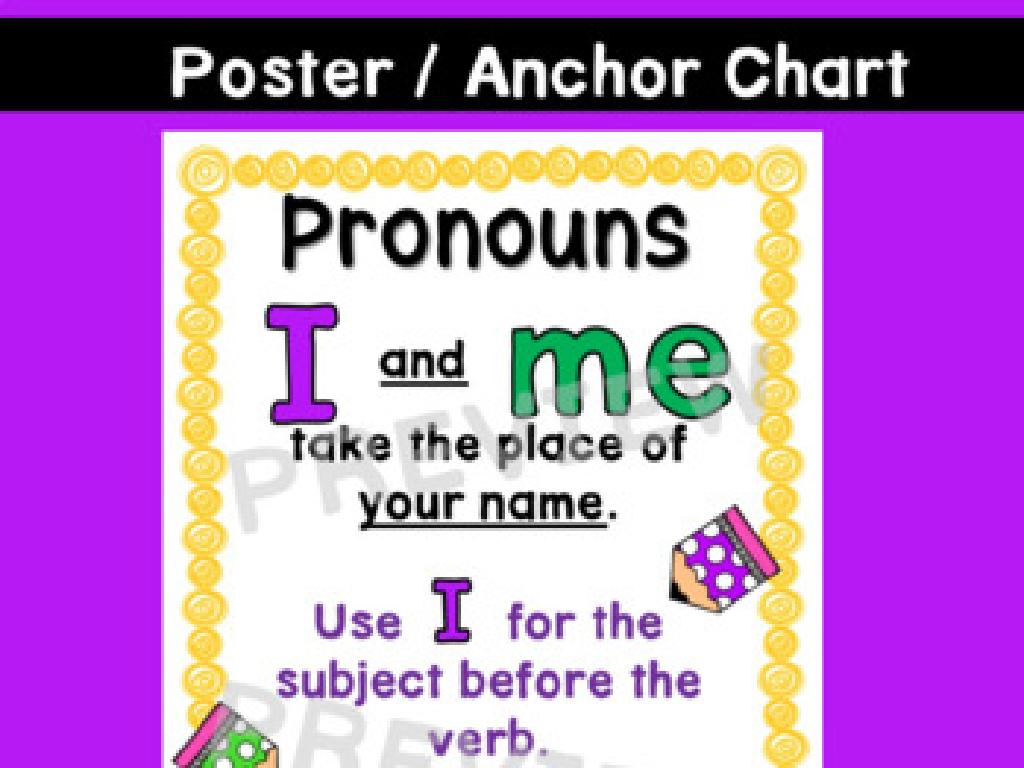Compare Fractions Using Models
Subject: Math
Grade: Third grade
Topic: Compare Fractions
Please LOG IN to download the presentation. Access is available to registered users only.
View More Content
Welcome to Fractions: Comparing Parts of a Whole
– Learn to compare fractions
– Understand parts of a whole
– A whole can be divided into equal parts; each part is a fraction of the whole.
– Importance of fraction comparison
– Comparing fractions helps in cooking, shopping, and sharing equally.
– Use models for comparison
– Draw shapes like pizzas or pies, divide them, and compare the pieces.
|
This slide introduces the concept of comparing fractions to third-grade students. Begin by explaining that a fraction represents a part of a whole, and it’s important to understand how to compare these parts to determine which is larger or smaller. Emphasize the practical applications of comparing fractions in everyday life, such as dividing a pizza among friends or measuring ingredients for a recipe. Use visual aids like fraction models to illustrate how fractions can be compared by looking at the number of equal parts. Encourage students to think of real-life scenarios where they might need to compare fractions. The goal is to make the concept relatable and understandable through hands-on activities and examples.
Understanding Fractions
– A fraction is part of a whole
– Like a slice of pizza from a whole pie
– Numerator and denominator explained
– Top number (slices you have), bottom number (total slices)
– Fractions in everyday life
– Examples: 1/2 of a sandwich, 3/4 of a water jug
|
Begin by explaining that a fraction represents a piece of something that is complete. Use tangible examples like a pizza cut into equal slices to illustrate this concept. Clarify that the numerator, the top number, indicates how many parts we have, while the denominator, the bottom number, shows the total number of equal parts in the whole. Provide relatable examples such as dividing a sandwich into halves or measuring water in a jug to show fractions in daily life. Encourage students to think of other examples and to visualize fractions as parts of any whole object or quantity.
Visualizing Fractions with Models
– Models show us fractions visually
– Fraction circles and bars compare sizes
– Circles and bars can be divided into equal parts to represent different fractions.
– Practice identifying fractions
– We’ll use models to recognize what fractions look like.
– Understand fractions better
– Seeing fractions helps grasp concepts like equivalence and comparison.
|
This slide introduces students to the concept of visualizing fractions using models such as fraction circles and bars. These models are tangible ways for students to understand the size and value of fractions by comparing them visually. During the lesson, demonstrate how to divide circles and bars into equal parts to represent different fractions. Encourage students to practice by identifying fractions using these models, which will help them understand how fractions can be equivalent and how to compare them. Provide various examples and let students manipulate the models to solidify their understanding. The goal is for students to become comfortable with fractions as a visual representation of parts of a whole.
Understanding Equivalent Fractions
– Fractions can look different but be equal
– Example: 1/2 equals 2/4
– Both fractions fill the same amount of a shape
– Using models to find equivalents
– Draw shapes and divide into equal parts. Shade the same area in different ways
– Practice with different fractions
– Try finding equivalents for 1/3, 3/6, 2/5, and 4/10
|
This slide introduces the concept of equivalent fractions, which is fundamental for understanding how different fractions can represent the same value. Start by explaining that even though fractions like 1/2 and 2/4 have different numerators and denominators, they can still be equal because they represent the same portion of a whole. Use visual aids like pie charts or bar models to show how shading the same proportion in different ways can help us see the equivalence. Encourage students to draw their own models and find equivalent fractions, reinforcing the concept through practice. This will prepare them for comparing fractions and understanding that fractions can be expressed in multiple forms but still be equal in value.
Comparing Fractions with the Same Denominator
– Fractions with identical denominators
– Larger numerators mean larger fractions
– Examples using visual models
– For example, 3/8 vs 5/8: which is larger?
– Practice problems for mastery
– Solve problems like 2/4 vs 3/4
|
This slide introduces the concept of comparing fractions that have the same denominator. Emphasize that when fractions have the same bottom number, or denominator, they are parts of the same whole. Therefore, the fraction with the larger top number, or numerator, represents a larger part of that whole. Use visual aids like pie charts or bar models to illustrate this concept with examples such as comparing 3/8 to 5/8, highlighting that 5/8 is larger because it has more parts of the whole. Provide practice problems such as comparing 2/4 to 3/4 to reinforce the concept. Encourage students to draw models of the fractions to visually compare them and understand why one is larger than the other.
Comparing Fractions with Different Denominators
– Use models to compare fractions
– Draw shapes divided into parts to show fractions
– Find common denominators
– Make the denominators the same to compare easily
– Practice with visual aids
– Use pictures to see which fraction is larger
– Understand fraction equivalence
|
This slide introduces the concept of comparing fractions with different denominators by using visual models. Students will learn to draw or use shapes like circles or bars divided into different numbers of equal parts to represent each fraction. They will then find common denominators by making the number of parts in each model the same, which will allow for an easier comparison. Visual aids such as fraction strips or pie charts can be particularly helpful in this process. Encourage students to practice by drawing their own models and using visual aids provided in class. The goal is for students to understand that fractions can be equivalent even if they look different, and that finding a common denominator is a key step in comparing them.
Using Benchmarks to Compare Fractions
– Understand benchmarks 0, 1/2, and 1
– Benchmarks are reference points we use to compare things.
– Is it more or less than 1/2?
– Decide if a fraction is smaller or larger than 1/2.
– Practice with fraction models
– Use shapes like circles or bars to visualize fractions.
– Comparing fractions made easy
|
This slide introduces the concept of using benchmarks to compare fractions. Benchmarks are standard points of reference that can be used to determine the relative size of fractions. Start by explaining what benchmarks are and how they can be used in the context of fractions. Emphasize the importance of the 1/2 benchmark, as it is a key reference point for determining whether a fraction is greater than, less than, or equal to 1/2. Provide students with visual models such as pie charts or bar models to practice placing fractions in relation to these benchmarks. Encourage students to think about fractions in terms of their distance from 0, 1/2, or 1 to help them compare sizes. This method simplifies the comparison process and builds a strong foundation for understanding more complex fraction concepts.
Let’s Compare Fractions!
– Observe fraction models
– Look at pie charts or bar models showing fractions
– Decide the larger fraction
– Which fraction model shows a bigger piece of the pie?
– Apply comparison skills
– Use the rules we’ve learned to compare two fractions
– Engage in group activity
– Work with classmates to compare different fractions
|
This slide is designed to encourage hands-on learning through visual aids and peer interaction. Begin by showing students models of fractions, such as pie charts or bar graphs, and ask them to observe which fractions represent a larger or smaller part of the whole. Reinforce the concept that fractions with the same denominators can be directly compared by looking at their numerators. For the group activity, divide the class into small groups and provide each group with fraction model cards. Each student picks two cards and works with their group to determine which fraction is larger using the models and what they’ve learned about comparing fractions. This activity promotes collaborative learning and helps solidify the concept of fraction comparison.
Class Activity: Fraction Scavenger Hunt
– Find classroom items as fractions
– Compare fractions of items
– Which item shows a bigger or smaller fraction?
– Present your fraction discoveries
– Share what you found and how you decided on the fractions
– Reflect on fraction comparisons
– Why do some fractions represent more or less than others?
|
This interactive activity encourages students to explore their environment to find real-world examples of fractions. Provide students with examples of items that could represent fractions, such as a half-eaten apple or a book divided into chapters. Guide them to compare the fractions they find by considering the size of the parts and the number of equal parts in a whole. When presenting, students should explain how they determined the fractions and why they think one fraction is larger or smaller than another. This will help them understand the concept of comparing fractions visually and conceptually. Possible activities include comparing portions of snacks, pieces of paper cut into fractions, or sections of a classroom bookshelf.
Conclusion: Comparing Fractions with Models
– Review comparing fractions
– We use models like pie charts to see which fraction is bigger.
– Understand importance of this skill
– Comparing fractions helps us in making fair decisions and understanding portions.
– Get ready for the next fractions lesson
|
As we wrap up today’s lesson, let’s revisit the concept of comparing fractions using visual models such as pie charts or bar diagrams. Understanding how to determine which fraction is larger or smaller is a crucial skill in math and in real-life situations, like dividing a pizza among friends or measuring ingredients for a recipe. Emphasize the practical applications of this skill to ensure students appreciate its value. Looking ahead, we’ll continue to explore fractions, building on what we’ve learned today. Encourage the students to practice at home with real-life examples and to come prepared for an exciting next lesson on fractions.

